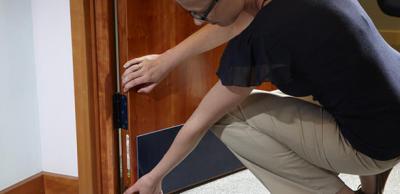ASFP offers fire-stopping installation guidance video
If you’re working on any compartment wall such as an attached garage to a dwelling, or a protected staircase in offices, then you must make sure that the integrity of the wall isn’t compromised.
A common problem is running service pipes or internet cables through parts of the building. Even though holes made may be small, the implications can be devastating. The major fire at Lakanal House in London in 2009 was a tragic example of how things can go wrong.
Video guidance from ASFP
The Association for Specialist Fire Protection (ASFP) has released a video (available to watch at the bottom of this page) to provide guidance on the correct specification and installation of fire-stopping.
The video describes the vital role of compartmentation in limiting the spread of fire and smoke within buildings and explains why any breaches in compartment walls and floors for service openings must be properly sealed, or ‘fire-stopped’, to ensure their continued performance.
It also highlights the importance of ensuring that the product to be used has been tested or certificated for the specific use intended.
Featuring footage of a 60-minute fire test carried out on behalf of ASFP, the video clearly demonstrates how correctly installed fire-stopping can effectively hold back smoke and fire; while incorrectly chosen and installed fire-stopping will fail, allowing smoke and flames to quickly spread.
Alarmingly, it shows that in less than 10 minutes, all of the fire-stopping examples where foam was inappropriately used in a situation for which it was not designed and tested, have completely failed.
Caution when using PU foam
The video advises that any installations fire-stopped with a PU foam whose performance has only been demonstrated using a reaction to fire test or which only claims a reaction to fire class should not be used for fire-stopping and should be replaced with a fire-stopping product/system which has been successfully proven for the end-use application in question.
It adds that unless the fire test data clearly states otherwise, such foams are usually only suitable for small apertures (less than 6mm) in a compartment wall or floor.
The ASFP recommends that specifiers must ensure that every passive fire protection product used offers suitable test/certification evidence for the end-use of the product, and that all those installing such products must be able to demonstrate competency in their installation.
The Association explains that the best way of ensuring this is to specify third party certificated products, installed by a third party certificated installer.
LABC and ASFP are working together to offer a range of regional seminars during 2017. The first will take place in Manchester on 26 April.
Watch the video
Further information
Read LABC's guidance on the use of polyurethane foam in fire-resisting applications
Find out about ASFP's fire protection seminars.
Visit the ASFP website for further fire protection guidance. www.asfp.org.uk
Please Note: Every care was taken to ensure the information was correct at the time of publication. Any written guidance provided does not replace the user’s professional judgement. It is the responsibility of the dutyholder or person carrying out the work to ensure compliance with relevant building regulations or applicable technical standards.
Sign up to the building bulletin newsletter
Over 48,000 construction professionals have already signed up for the LABC Building Bulletin.
Join them and receive useful tips, practical technical information and industry news by email once every 6 weeks.
Subscribe to the Building Bulletin




Comments
(No subject)
Submitted 7 years 1 month ago
Add new comment